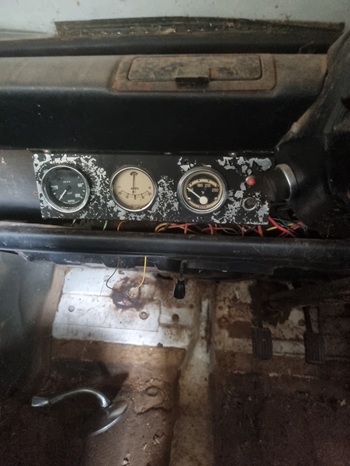
Still writing and updating (February 2025)
I made the following modifications in the 1970's
The car came
without a heater. I had one installed not long after I purchased it
in 1969.
I fitted three gauges to the cars. Most young men fitted them
to their cars. An oil pressure gauge with a plastic tube to the
engine, an ammeter meter, and an electrical temperature gauge. Also
fitted was a reversing light with a pilot light above the switch. The
paintwork has deteriorated during storage.
The 12V battery was moved from the car's rear to the front on
top of the petrol tank in a steel frame with a plastic square
container. I purchased a starter cable from a wrecked mini. They had
the engine in the front and the battery in the rear boot. The change
in battery position allows the air cleaner to be moved into the
battery position. The air cleaner did not have to be removed to work
on the driver's side of the engine. The battery was in a better
environment and may have had a better life.
Electronic Australia published an electronic ignition system.
I purchased a kit, soldered it together, and fitted it. It used the
existing coil and points. The main advantage was starting was better
when the battery was low. Electronic ignition systems are now
standard on modern cars.
I fitted a Positive Crankcase Valve (RCV) to the Imp. The crankcase was originally vented between the air cleaner and just before the carburettor. I vented it into the inlet manifold between the carburettor and the inlet valves, which was becoming standard then.
Both the PCV and the electronic ignition resulted in a slight
improvement in fuel economy.
I fitted a homemade tow bar. Cars at this time did not have a
towing rating.

During storage, a 1 in 200-year flood
flooded the storage shed. Water was up to the bottom of the brake
drums. The water resulted in the brake drums rusting onto the brakes.
I got three brake drums off. But I cut off the fourth one with an
angle grinder. 28/7/2012
The Imp has finally come home for a
restoration for club permit registration 12/07/15
The trailer was loaded correctly because of the Imp's shortness and the trailer's length, and but the tow ball still had the required weight on it.

After many delays the Imp came back to Leopold. Brake cylinders where purchased. Fitting the master cylinders required the petrol tank to be removed with may years the the petrol had evaporated. A plate containing the brake and clutch was removed and new cylinders fitted. Reconnecting the the petrol line (steel) broke it had rusted away. New wheel cylinders where fitted.
The new wheel cylinders had 3/8 UNF thread connection for the brake hoses. The brake bleeder are made from metric hexagonal steel and are now need 10mm AF spanner is used to bleed the brakes. The rear back passenger side cylinder the pipe connection started to go on cross threaded, removed and run tape down it, now all OK. The same wheel the the brake adjuster needed oiling and freeing up. Relined brake shoes where fitted.
Bleeding the brakes brake fluid would not come out of the front driver side bleeder. The blockage was found in a rubber flexible hose to the brake cylinder. Replacement hoses for all brakes where purchased from Argentina. New brake drums where fitted.
After many years of using metric spanners, it is much better than SAE (Imperial ) spanners. The next size bigger than an 8mm spanner is a 9mm. With the imperial spanner, it is 5/16 into 11/32in.